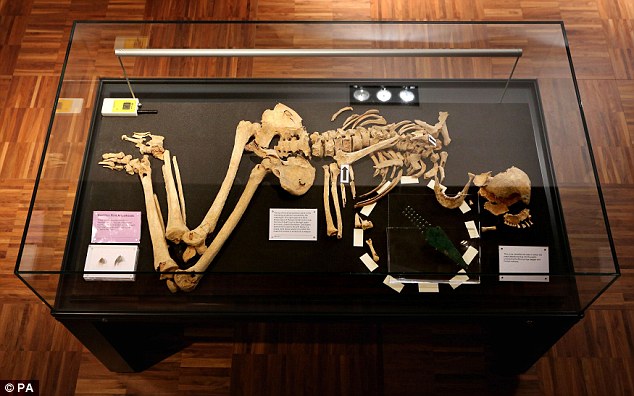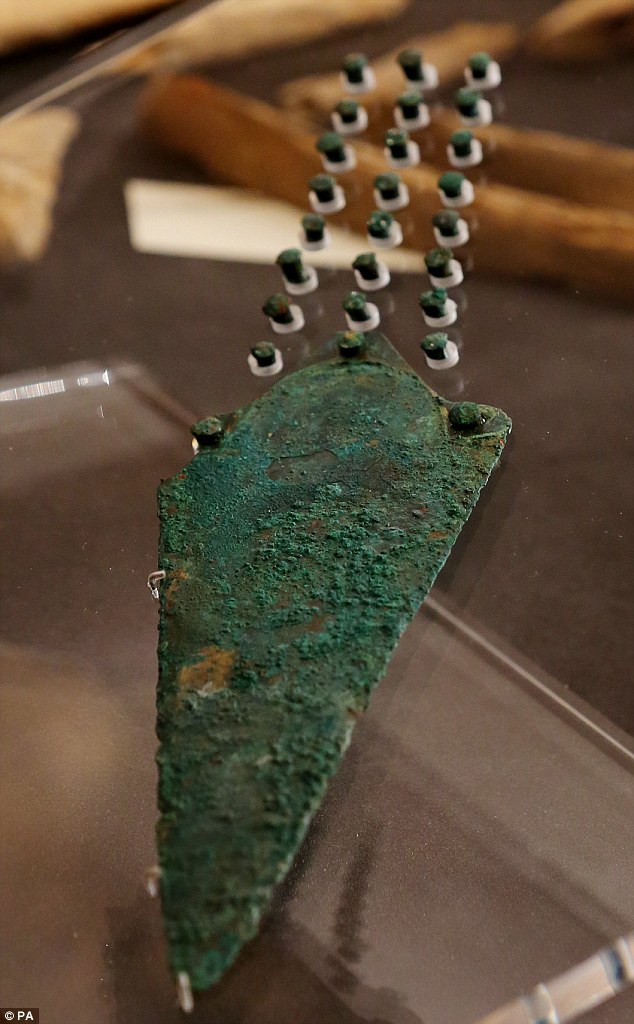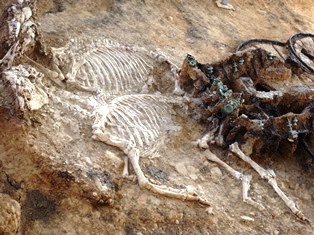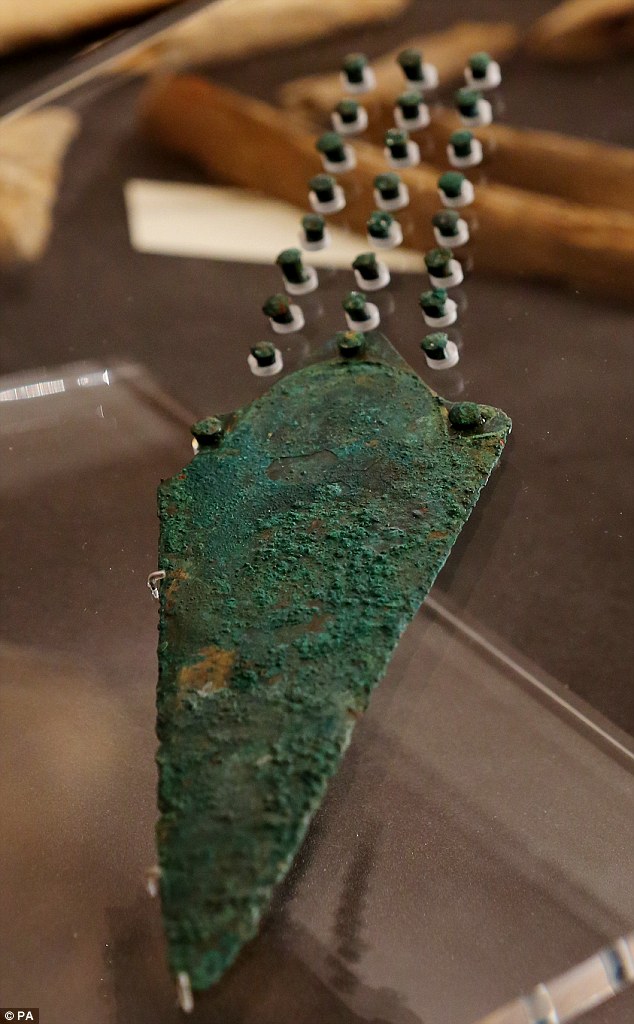It looks like you're using an Ad Blocker.
Please white-list or disable AboveTopSecret.com in your ad-blocking tool.
Thank you.
Some features of ATS will be disabled while you continue to use an ad-blocker.
17
share:
For more than 4,000 years, the remains of a man who was likely a formidable warrior chieftain, lay buried in the corner of a field near the hamlet of
Racton in southeastern England. Dubbed the 'Bronze Age Superman' by the media, he stood 6' or more and analysis of his remains show that he lived well
into his 40's — an impressive height and age for a man of that time and place.
Radiocarbon dating of the man's teeth and bones put his death at somewhere between 2,150 B.C. and 2,300 B.C. Evidence of unhealed wounds are consistent with a death in battle.
 Racton Man at Novium Museum in Chichester. Image Credit: PA via Dailymail
Racton Man at Novium Museum in Chichester. Image Credit: PA via Dailymail
After the discovery of the 'Racton Man' in 1989, his skeleton and the ornate bronze dagger that he clasped in his hands, sat for 23 years in museum storage until a conversation between two archaeologists led to renewed interest (and funding) and the result was the belated discovery of the oldest accurately dated bronze object to have been located in Britain and one of the oldest ever found in Europe.
 Racton Man's Dagger. Image Credit: PA via Dailymail
Racton Man's Dagger. Image Credit: PA via Dailymail
From The Guardian:
The dagger, unique not only for the composition of its bronze, had a rivet-studded hilt wooden or bone handle and would have been a glinting object of cutting-edge technology (literally) at the time. According to the Novium Museum site, only three similar daggers have been unearthed in Britain and another three in Ireland.
Additional sources:
Ancient Origins
Daily Mail
Huffington Post
Novium Museum
Radiocarbon dating of the man's teeth and bones put his death at somewhere between 2,150 B.C. and 2,300 B.C. Evidence of unhealed wounds are consistent with a death in battle.

After the discovery of the 'Racton Man' in 1989, his skeleton and the ornate bronze dagger that he clasped in his hands, sat for 23 years in museum storage until a conversation between two archaeologists led to renewed interest (and funding) and the result was the belated discovery of the oldest accurately dated bronze object to have been located in Britain and one of the oldest ever found in Europe.

From The Guardian:
The results startled everyone. Kenny described Racton Man as “a big man” and he was literally that. To have owned such a high-status object he must have been a leader, possibly a tribal chieftain, but he also stood six foot tall, and had lived into his late 40s, much longer than the average life expectancy.
Isotope analysis of one of his teeth showed he had not come from the chalk downland of Sussex but from the West Country or just possibly Ireland or Brittany.
The copper in the bronze was also a rare type in Britain known as arsenic-only copper, which may have been specially prized because, although they couldn’t have understood the chemistry, the higher the arsenic content the harder the eventual bronze. The copper was probably imported, but the workmanship of the dagger was British.
The dagger, unique not only for the composition of its bronze, had a rivet-studded hilt wooden or bone handle and would have been a glinting object of cutting-edge technology (literally) at the time. According to the Novium Museum site, only three similar daggers have been unearthed in Britain and another three in Ireland.
Additional sources:
Ancient Origins
Daily Mail
Huffington Post
Novium Museum
edit on 2014-12-18 by theantediluvian because: (no reason
given)
So mankind has been forging and mixing metals for a long time. I'm sure this is not the first one, the technology may have been around for a long
time before. He may have acquired it from his father or taken it from someone who got it from who knows who or when. Something like that would be
desired by a person.
I wonder how long we have really been melting metals. Just because we haven't found evidence yet, doesn't mean it didn't happen, it just means we need to find more evidence.
I wonder how long we have really been melting metals. Just because we haven't found evidence yet, doesn't mean it didn't happen, it just means we need to find more evidence.
S&F for a good story OP.
I wish that archeology was a bit more science based rather than funding based.
They have a skeleton, a dagger and they worked out dates. All well done.
But they just can't seem to leave it to the facts. They have to sex it up as far as they can get.
Well no!
It is one possibility. He could have been a damn mercenary and acquired the blade in battle.
He could (probably was at 6' tall) one of the best fighting men and was given the dagger.
He could have been a smith and made the dagger from other broken weapons from previous battles.
I would suggest he could have been a thief and stole the blade but I can't see someone burying him with it unless it was due to superstition.
Every body they find has to have a fabricated sexy story attached to it from the wild imaginings of supposedly science based archeologists.
He could have been an ordinary soldier buried with the blade as a tribute to how many he killed. Who knows and we certainly don't. But let's call him a chieftain or a king because we are more likely to get additional funding.
P
I wish that archeology was a bit more science based rather than funding based.
They have a skeleton, a dagger and they worked out dates. All well done.
But they just can't seem to leave it to the facts. They have to sex it up as far as they can get.
To have owned such a high-status object he must have been a leader, possibly a tribal chieftain.
Well no!
It is one possibility. He could have been a damn mercenary and acquired the blade in battle.
He could (probably was at 6' tall) one of the best fighting men and was given the dagger.
He could have been a smith and made the dagger from other broken weapons from previous battles.
I would suggest he could have been a thief and stole the blade but I can't see someone burying him with it unless it was due to superstition.
Every body they find has to have a fabricated sexy story attached to it from the wild imaginings of supposedly science based archeologists.
He could have been an ordinary soldier buried with the blade as a tribute to how many he killed. Who knows and we certainly don't. But let's call him a chieftain or a king because we are more likely to get additional funding.
P
edit on 18/12/2014 by pheonix358 because: (no reason given)
a reply to: pheonix358
So true, I bugbear of mine when it comes to history. Assumptions made to create a hyper story. I mean, he's just a tall guy who lived long, but the reports can't say that, they have to sex it up. He may have found the blade whilst out ploughing his land, his wife knew he loved it so buried him with it... anything, literally millions of possibilities.
That said, what a brilliant find.
Anything skeletal which sets a scene conjours up tales in one's mind. Take this Bulgarian neolithic (I think) cart being pulled by two horses:

So true, I bugbear of mine when it comes to history. Assumptions made to create a hyper story. I mean, he's just a tall guy who lived long, but the reports can't say that, they have to sex it up. He may have found the blade whilst out ploughing his land, his wife knew he loved it so buried him with it... anything, literally millions of possibilities.
That said, what a brilliant find.
Anything skeletal which sets a scene conjours up tales in one's mind. Take this Bulgarian neolithic (I think) cart being pulled by two horses:

a reply to: theantediluvian
Considering the average european was what, 4 and a half feet tall back then, he must have seemed like a giant! Or else scandinavian
Considering the average european was what, 4 and a half feet tall back then, he must have seemed like a giant! Or else scandinavian
I wonder if his name was Richard, of course we will never know, if the skeleton has not got Spina Bifida, probably not.
I find it interesting that the prevalent attitude of archeologists and other experts seems to be that a "superior" weapon made the man, even though it
may be by way of a ritual burial object.
In all reality, a freshly fashioned flint knife would be sharper and just as effective in battle. What ever great things this "leader" did are far more important than the gold watch they gave him when he "retired".
I can understand this do to working with the evidence at hand, but it limits the possibilities.
In all reality, a freshly fashioned flint knife would be sharper and just as effective in battle. What ever great things this "leader" did are far more important than the gold watch they gave him when he "retired".
I can understand this do to working with the evidence at hand, but it limits the possibilities.
edit on 19-12-2014 by MichiganSwampBuck because: Typo
a reply to: pheonix358
"But they just can't seem to leave it to the facts. They have to sex it up as far as they can get."
I agree! But most of the time with ancient burials, we only have funerary goods to try and interpret the burial. Kings and other highly respected people left their accomplishments carved in stone elsewhere.
But I'm intrigued by Bronze.
www.uwgb.edu...
LEGACY OF THE ANCIENT WORLD
"Bronze is an alloy of copper and tin. Copper and tin minerals rarely occur together and there is no abundant source of tin in the Middle East. The nearest source known is in Afghanistan, a plausible place because a precious blue stone, lapis lazuli, comes from the same region and was widely traded in ancient times.
"Nevertheless, it is a deep mystery how bronze came to be discovered. But it was the first industrial metal; much harder than copper and able to maintain a sharp edge. The fact that the earliest metalworking period is called the Bronze Age is testimony to the importance of bronze."
(And the fact it was discovered independently in China, only adds to the mystery.)
www.sjsu.edu...
ADVANCED TECHNOLOGY OF ANCIENT CHINA
"Casting of bronze objects developed very early in the Shang Civilization of the Yellow River Valley of about 1800 BCE. Religious objects, as well as tools and weapons, of great artistic merit were cast."
"But they just can't seem to leave it to the facts. They have to sex it up as far as they can get."
I agree! But most of the time with ancient burials, we only have funerary goods to try and interpret the burial. Kings and other highly respected people left their accomplishments carved in stone elsewhere.
But I'm intrigued by Bronze.
www.uwgb.edu...
LEGACY OF THE ANCIENT WORLD
"Bronze is an alloy of copper and tin. Copper and tin minerals rarely occur together and there is no abundant source of tin in the Middle East. The nearest source known is in Afghanistan, a plausible place because a precious blue stone, lapis lazuli, comes from the same region and was widely traded in ancient times.
"Nevertheless, it is a deep mystery how bronze came to be discovered. But it was the first industrial metal; much harder than copper and able to maintain a sharp edge. The fact that the earliest metalworking period is called the Bronze Age is testimony to the importance of bronze."
(And the fact it was discovered independently in China, only adds to the mystery.)
www.sjsu.edu...
ADVANCED TECHNOLOGY OF ANCIENT CHINA
"Casting of bronze objects developed very early in the Shang Civilization of the Yellow River Valley of about 1800 BCE. Religious objects, as well as tools and weapons, of great artistic merit were cast."
a reply to: pheonix358
The crux of the argument in favor of a high status is that he was buried with an object that was exceedingly rare for the time. It seems very likely given the evidence of combat wounds and his burial with a weapon that he was a warrior. Given his apparent robustness and age at death, he was probably good at it (or at least not dying).
There is certainly an amount of sensationalizing that goes on to attract public interest and funding but there are other factors to consider. One the one hand, there is embellished speculation but there's also the fact that thousands and thousands of archaeological finds a year go unnoticed by the public. Keep in mind that it wasn't until the dagger was "rediscovered" by somebody who was more of an authority in the subject, that this man became newsworthy.
More generally, I'd guess that higher status individuals are also disproportionately represented if for no other reason then that their burials are typically much more elaborate than the average person's and so in practical terms, they're just more likely to be found thousands of years later. It's also true that in most cultures throughout history and around the world, the wealthy and powerful have nicer things in life and in death, so reasonable inferences about an individual's status can often be drawn from funerary objects.
The crux of the argument in favor of a high status is that he was buried with an object that was exceedingly rare for the time. It seems very likely given the evidence of combat wounds and his burial with a weapon that he was a warrior. Given his apparent robustness and age at death, he was probably good at it (or at least not dying).
There is certainly an amount of sensationalizing that goes on to attract public interest and funding but there are other factors to consider. One the one hand, there is embellished speculation but there's also the fact that thousands and thousands of archaeological finds a year go unnoticed by the public. Keep in mind that it wasn't until the dagger was "rediscovered" by somebody who was more of an authority in the subject, that this man became newsworthy.
More generally, I'd guess that higher status individuals are also disproportionately represented if for no other reason then that their burials are typically much more elaborate than the average person's and so in practical terms, they're just more likely to be found thousands of years later. It's also true that in most cultures throughout history and around the world, the wealthy and powerful have nicer things in life and in death, so reasonable inferences about an individual's status can often be drawn from funerary objects.
The blade is interesting in it shows how tradition overshadows utility.
You will note that the blade has no tang but was held to the handle by rivets. That was how stone tools were held to a handle (not by rivets of course) but by fashioning it by glue or strappings to hold the blade to the handle. This was always a weak point and often broke. When they went to metal they followed the tradition and one finds plentiful signs of broken rivets in such weapons. It was later that they figure out they could place the rivets on the tang and make a much more secure hold. This would seem to be common sense but the era of 'tangless weapons' last hundreds of years, thousands in some places.

You will note that the blade has no tang but was held to the handle by rivets. That was how stone tools were held to a handle (not by rivets of course) but by fashioning it by glue or strappings to hold the blade to the handle. This was always a weak point and often broke. When they went to metal they followed the tradition and one finds plentiful signs of broken rivets in such weapons. It was later that they figure out they could place the rivets on the tang and make a much more secure hold. This would seem to be common sense but the era of 'tangless weapons' last hundreds of years, thousands in some places.

edit on 19/12/14 by Hanslune because: added image
originally posted by: and14263
a reply to: pheonix358
So true, I bugbear of mine when it comes to history. Assumptions made to create a hyper story. I mean, he's just a tall guy who lived long, but the reports can't say that, they have to sex it up. He may have found the blade whilst out ploughing his land, his wife knew he loved it so buried him with it... anything, literally millions of possibilities.
The report does say he was buried with unhealed wounds, indicating he died in battle. Given his size, it seems reasonable to assume he was a warrior and given the burial items, probably high status, so I don't think anyone has "sexed" anything up more than what the evidence intimates.
originally posted by: pikestaff
I wonder if his name was Richard, of course we will never know, if the skeleton has not got Spina Bifida, probably not.
Huh? Not only did this guy die some 2,000 prior to Bosworth Field and had totally the wrong items buried with him, they already found Richard under a car park a couple of years back.
new topics
-
Oh, Good Gosh. “Kremlin Warns Stay Away from Greenland.”
World War Three: 1 hours ago -
Archbisop Vigano Warns of Deep State and Deep Church
New World Order: 1 hours ago -
A Flash of Beauty: Bigfoot Revealed ( documentary )
Cryptozoology: 7 hours ago -
Fire insurance in LA withdrawn months ago
General Conspiracies: 9 hours ago
top topics
-
Fire insurance in LA withdrawn months ago
General Conspiracies: 9 hours ago, 8 flags -
A Flash of Beauty: Bigfoot Revealed ( documentary )
Cryptozoology: 7 hours ago, 6 flags -
Oh, Good Gosh. “Kremlin Warns Stay Away from Greenland.”
World War Three: 1 hours ago, 4 flags -
Archbisop Vigano Warns of Deep State and Deep Church
New World Order: 1 hours ago, 3 flags
active topics
-
Los Angeles brush fires latest: 2 blazes threaten structures, prompt evacuations
Mainstream News • 300 • : 38181 -
Trump says ownership of Greenland 'is an absolute necessity'
Other Current Events • 93 • : bastion -
Fire insurance in LA withdrawn months ago
General Conspiracies • 26 • : sapien1982 -
Oh, Good Gosh. “Kremlin Warns Stay Away from Greenland.”
World War Three • 7 • : DAVID64 -
The Truth about Migrant Crime in Britain.
Social Issues and Civil Unrest • 45 • : covent -
Judge rules president-elect Donald Trump must be sentenced in 'hush money' trial
US Political Madness • 87 • : tkwaz -
A Flash of Beauty: Bigfoot Revealed ( documentary )
Cryptozoology • 4 • : CosmicFocus -
Archbisop Vigano Warns of Deep State and Deep Church
New World Order • 0 • : FlyersFan -
Planned Civil War In Britain May Be Triggered Soon
Social Issues and Civil Unrest • 33 • : sapien1982 -
Steering the Titantic from the Drydock.
Rant • 47 • : andy06shake
17
